
Grappling is a full-contact combat sport based on throws, trips, sweeps, clinch fighting, ground fighting and submission holds.
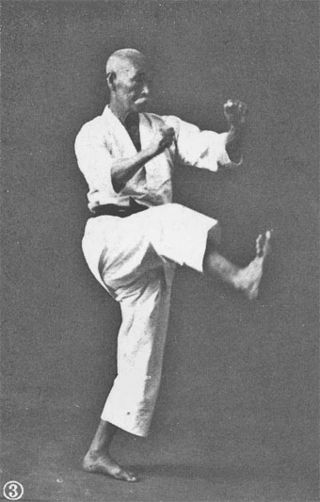
Karate (空手) is a martial art developed in the Ryukyu Kingdom. It developed from the indigenous Ryukyuan martial arts under the influence of Chinese martial arts, particularly Fujian White Crane. Karate is now predominantly a striking art using punching, kicking, knee strikes, elbow strikes, and open-hand techniques such as knife-hands, spear-hands, and palm-heel strikes. Historically, and in some modern styles, grappling, throws, joint locks, restraints, and vital-point strikes are also taught. A karate practitioner is called a karateka (空手家).
Martial arts are codified systems and traditions of combat practiced for a number of reasons such as self-defense; military and law enforcement applications; competition; physical, mental, and spiritual development; entertainment; and the preservation of a nation's intangible cultural heritage.

Taekwondo, Tae Kwon Do or Taekwon-Do is a Korean martial arts involving punching and kicking techniques, with emphasis on head-height kicks, spinning jump kicks, and fast kicking techniques. The literal translation for tae kwon do is "kicking", "punching", and "the art or way of". They are a kind of martial arts in which one attacks or defends with hands and feet anytime or anywhere, with occasional use of weapons. The physical training undertaken in Taekwondo is purposeful and fosters strength of mind through mental armament.
Randori (乱取り) is a term used in Japanese martial arts to describe free-style practice (sparring). The term denotes an exercise in 取り tori, applying technique to a random succession of uke attacks.

Shotokan is a style of karate, developed from various martial arts by Gichin Funakoshi (1868–1957) and his son Gigo (Yoshitaka) Funakoshi (1906–1945). Gichin Funakoshi was born in Okinawa and is widely credited with popularizing "karate do" through a series of public demonstrations, and by promoting the development of university karate clubs, including those at Keio, Waseda, Hitotsubashi (Shodai), Takushoku, Chuo, Gakushuin, and Hosei.
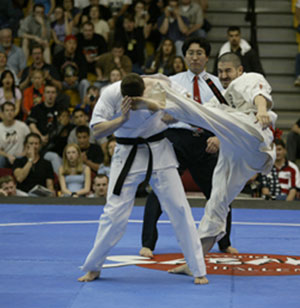
Full contact karate is any format of karate where competitors spar full-contact and allow a knockout as winning criterion.

Kumite is one of the three main sections of karate training, along with kata and kihon. Kumite is the part of karate in which a person trains against an adversary.
The following outline is provided as an overview of and topical guide to martial arts:
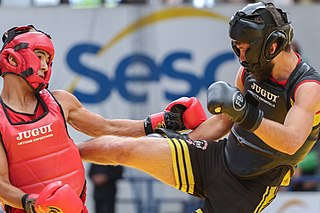
Sanda, formerly Sanshou, also known as Chinese boxing or Chinese kickboxing, is the official Chinese kickboxing full-contact combat sport. Sanda is a fighting system which was originally developed by the Chinese military based upon the study and practices of traditional kung fu and modern combat fighting techniques; it combines boxing and full-contact kickboxing, which includes close range and rapid successive punches and kicks, with wrestling, takedowns, throws, sweeps, kick catches, and in some competitions, even elbow and knee strikes.
A combat sport, or fighting sport, is a competitive contact sport that usually involves one-on-one combat. In many combat sports, a contestant wins by scoring more points than the opponent, submitting the opponent with a hold, disabling the opponent, or attacking the opponent in a specific or designated technique. Combat sports share a long pedigree with the martial arts.

Tang Soo Do refers to a Korean martial art based on Karate and may include fighting principles from taekkyeon, subak, as well as northern Chinese martial arts. Before the Nine Kwans united and formed the martial art Taekwondo, Tang Soo Do was used by select Kwans to identify their Karate-derived martial arts style.

The front kick in martial arts is a kick executed by lifting the knee straight forward, while keeping the foot and shin either hanging freely or pulled to the hip, and then straightening the leg in front of the practitioner and striking the target area. It is desirable to retract the leg immediately after delivering the kick, to avoid the opponent trying to grapple the leg and to return to stable fighting stance.

Kata is a Japanese word meaning "form". It refers to a detailed choreographed pattern of martial arts movements made to be practised alone. It can also be reviewed within groups and in unison when training. It is practised in Japanese martial arts as a way to memorize and perfect the movements being executed. Korean martial arts with Japanese influence use the derived term hyeong and also the term pumsae.

A contact sport is a sport in which bodily contact is necessary. The amount of physical contact implicated varies by sport, meaning "contact" is a relative descriptor. A foul in basketball, football, and boxing all look different. Since physical contact is a major component of each game, they all qualify as contact sports.
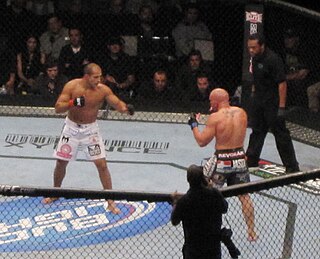
In martial arts and combat sports, stand-up fighting is hand-to-hand combat between opponents in a standing position, as distinguished from ground fighting. Clinch fighting is stand-up grappling. Fighters employ striking, including striking combinations, using either body parts or mêlée weapons, to incapacitate or injure the opponent. Combatants use blocking techniques to block the opponent's attacks.

Hogu (호구) is the armor worn by practitioners of Taekwondo and Geomdo during sparring and competition. Translated into English, hogu means chest or chest protector.
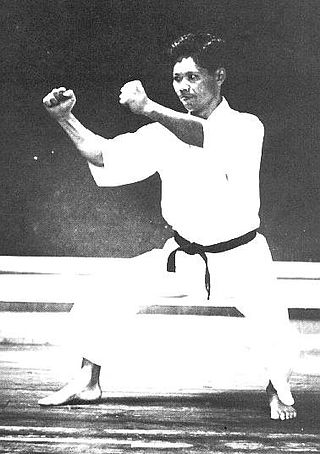
Gigō Funakoshi was the third son of Gichin Funakoshi and is widely credited with developing the foundation of the modern karate Shotokan style.
This martial arts timeline is designed to help describe the history of the martial arts in a linear fashion. Many of the articles for particular styles have discussions of their history. This article is designed to help visualize the development of these arts, to help better understand the progression of the separate styles and illustrate where they interrelate.
Kanbukan was one of the earliest Karate organizations made in Post-War Japan and is considered the birthplace of the Bōgutsuki Karate.
















